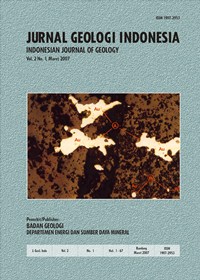Evolusi pengendapan sedimen Kuarter di daerah utara Air Musi, Kota Palembang - Sumatera Selatan
DOI:
https://doi.org/10.17014/ijog.2.1.1-13Keywords:
facies, depositional environment, climate, stratigraphyAbstract
https://dx.doi.org/10.17014/ijog.vol2no1.20071
In the studied area, the sedimentary Quaternary facies consists of fl uvial channel separated by fl oodbasin, swamp, and fl oodplain deposits. Changes in channel style from channel 1, 2, and to 3 are interpreted as the result of a change in the type of river discharge from low to high sinuosity channels. Vertical changes in the character of these fl uvial channels can be related to changes in humidity. The lateral and vertical succession of the fl oodbasin and swamp environments shows evidence of decreasing and increasing of these facies. They are the result of changes in climate.
Vertical changes of the Quaternary deposit successions can be related to changes in climate. It is concluded that the subinterval facies I.a to I.c as form of channel 2 and fl oodplain facies (subinterval facies I.b) refl ects a continuosly increase in climate from minimum to climatic maximum. Whereas, from the subinterval facies I.c to II.c during deposition of the subinterval facies II.b by the occurrence of fl oodbasin facies 2, the humid climate decreased from climatic maximum to minimum. Probably, this can be called as astrostratigraphy or orbital stratigraphy.
References
Allen, J.R.L., 1965. A review of the origin and character of recent sediments. Sedimentology, 5, p. 89-191.
Allen, J.R.L., 1983. Studies in fl uviatile sedimentation: bars, bar complexes and sandstone sheets (low-sinuosity braided streams) in the Brownstones (L. Devonian), Welsh Breders. Sedimentary Geology, 33, p. 237-293.
Amos, C.L., 1978. The post-glacial evolution of the Minas Basin, Nova Scotia: A sedimentological interpretation. Journal of Sedimentary Petrology, 48, p. 962-982.
Badri, I., 1983. Penyelidikan Geologi Lingkungan Perkotaan Palembang dan sekitarnya, Sumatera Selatan. Direktorat Geologi Lingkungan, Tidak dipublikasikan.
Berger, A. 1988. Milankovitch Theory and climate. Review of Geophysics, 26, p. 624-657.
David, A. and Miall, A.D. 1991. Stratigraphy, sedimentology and evolution of a Vertebrate-bearing, braided to anastomosed fl uvial system, Cutler Formation (Permian- Pennsylvanian), north-central New Mexico. Sedimentary Geology, 72 (1991), p. 225-252.
Dalrymple, R.W. and Zartlin, B.A., 1994. High resolution sequence stratigraphy of a complex, incised valley succession, Cobequid Bay – Salmon River estuary, Bay of Fundy, Canada. Sedimentology (1994), 41, p. 1069-1091.
Gafoer, S., Burhan, G., dan Purnomo, J., 1995. Peta Geologi Lembar Palembang, Sumatera Selatan, skala 250.000. Puslitbang Geologi, Dit. Jend. Geologi dan Sumberdaya Mineral, Bandung.
International Subcommission on Stratigraphic Classifi cation (ISSC) of IUGS International Commission on Stratigraphy, 2001. Circular No. 99, p. 1-10.
Miall, A.D., 1988. Facies architecture in clastic sedimentary basins. In: K. Kleinspehn and C. Paola (Editors), New Perpective in Basin Analysis. Springer-Verlag, New York, p. 67-81.
Milankovitch Cycles and Glacial, 2003. https://www.homepage.montana.edu/~hyperlac/time1/milankov. htm.
Olsen, H., 1993. Orbital forcing on continental depositional systems-lacustrine and fluvial cyclicity in the Devonian of East Greenland. Special Publications of International Association of Sedimentologist (1993) 19, p. 429-438.
Perlmutter, M.A. and Matthews, M.A., 1989. Global Cyclostratigraphy. In: T.A. Cross (ed.), Quantitative Dynamic Stratigraphy. Prentice Englewood, New Jersey, p. 233-260.
Pestiaux, P., Duplessy, J.C. ,Van der Mersch, I., and Berger, A., 1988. Paleoclimatic variability at frequencies ranging from 1 cycle per 10,000 years to 1 cycle per 1,000 years: Evidence for non-linear behavior of the climate system, Climatic Change, 12 (1), p. 9-37.
Plate Tectonics and Glacier Formation, 2003. https://www.homepage.montana.edu/~geol445/hyperglac/time1/tectonic.htm.
Pye, L., 2004. Cyclostratigraphy: Big Words, Heavy Meaning. https://www.coastvillage.com/origins/Pye/ cyclostratigraphy.htm., p. 1-5.
Reineck, H.E. and Singh, I.B., 1980. Depositional Sedimentary Environments, Springer-Verlag, Berlin, 549pp.
Stea, R.R. and Wightman, D.M., 1987. Age of the Five Islands Formation, Nova Scotia, and deglaciation of the Bay of Fundy. Quarternary Research, 27, p. 211-219.
Williams, M.A.J., Dunkerley, D.L., De Decker, P., Kershaw, A.P., and Stokes, T.J., 1993. Quaternary Environments. Edward Arnold, A division of hodder & Stoughton, London New York Melbourne Auckland, 329pp.



















